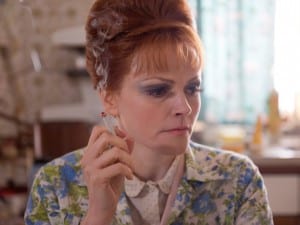Traversing the boundaries between social and personal interests, thriller and realism, Pour Elle forces everyday characters to extraordinary lengths.
In a fractured society, we experience increasing difficulty determining between right and wrong, negotiating society’s boundaries and understanding how far it’s possible to transgress in pursuit of a good cause. Cinema creates a window not only to aspects of lives outside of our own world, but also to the possibilities within our everyday experience. Fred Cavayé’s first feature length film, Pour Elle (Anything for Her) is unique in its exposition of the everyman, and is gripping primarily for the plainness of its characters.
Julien and Lisa are an average couple, blissfully wed, with a young son, Oscar, until their situation changes drastically when Lisa is arrested on charges of murder. Three years pass and Lisa is sentenced to 20 years imprisonment, a situation that sends her husband to desperate measures. The action is fast-paced and intense, as Julien becomes increasingly frantic, bypassing the French legal system, which has failed him and his wife, for the murky underworld of international crime. Meeting with a renowned escapee, Julien is forewarned that the criminal lifestyle is for the select few. To embark into this criminal world Julien must be 100% committed to his cause, must put his goal above everything else including other criminals, society, and his own family: “You have to be ready to do anything, whatever it takes.”
Fred Cavayé has an established reputation in French cinema through A L’arrache, Chedope and J, but this is his first feature-length film. On writing the screenplay with Guillaume Lemans, Cavayé says: “Guillaume proposed the idea of an ‘everyman’ character who will have to transcend himself to save the woman he loves.” The scripts were developed separately, before comparisons for the final draft, and the issues raised stem from questions that the writers would repeatedly pose to themselves: “Take an anonymous person and place him or her in a purely cinematic context. Put your ‘next-door neighbour’ in a thriller, “ blurring the boundaries of fiction and realism. Following in the footsteps of numerous screenwriter-directors such as Quentin Tarantino and Guillaume Canet, Cavayé assumed total control of production, “being the screenwriter simplifies many things. You know your subject well and know the ins and outs of each character. I am able to answer all the questions asked by the actors about their characters because I’ve written them.” Pour Elle conforms to the prison-break genre, but the film’s driving force and focal point is the love between husband and wife, and for this reason, in spite of the evidence against her, Julien neglects to question Lisa’s innocence. ”He knows her better than anyone else and he knows that she is telling the truth. I wanted to move away from the premise of a ‘romantic’ film. Even if she is guilty, without a doubt he would have acted in the same way.”
In the lead role, Vincent Lindon’s easy nonchalance is swiftly replaced by a fervent anxiety as the character transforms in desperation. In contrast, Diane Kruger is an odd choice for the role of Lisa, but Cavayé explains that casting a renowned beauty made the torture of her imprisonment more shocking, and Kruger lives up to the role of wrongly accused with a fragile tension. Lisa is beautiful, but her imprisonment, and Julien’s part in her escape are convincing. Cavayé was keen to root his situation in reality, so Julien stumbles across his fake documents through the lowest rungs of criminal society, a cigarette tout evading small change in taxes. For our everyman, these are the only visible instances of criminality. Julien is prepared to sacrifice their normality, their very identity for the re-creation of the family unit, ironically fleeing his own family, who for the most part, continue unaware of their son’s plot. In these extensive lengths to which a normal figure will transgress, Pour Elle showcases remarkable similarities with Canet’s French thriller, Ne le dis à personne (Tell No One), and the Hollywood-saturated genre shows significant signs of flourishing with French directors providing a quiet intensity.
The structure of Pour Elle employs a series of flashbacks, secondary information and narrative expositions. The audience become bystanders in the first scene of the prison break via unsteady camera actions and tilted framing to highlight Julien’s nervousness and the frenetic pace of the escape. Cavayé’s editing is significant, although she holds the title role, Lisa’s character is notable by her absence through much of the action. Infrequent visits from Julien and Oscar serve to patch together an idea of her wilting condition, but overall her imagined treatment and suffering in prison becomes more intense than what is screened. “Let the viewer imagine the atrocities that are happening to her and it becomes much stronger. It is always more interesting not to show exactly what is happening.” Lisa’s diabetes, her refusal to take her insulin, and her suicide attempt are reported second-hand, as the audience is focused on Julien, heightening the desperation of his escape plans. His predicament is empathetic because the relationship between the two is based on trust and honesty, and yet, Julien cannot risk telling Lisa the escape plan because of her unstable state.
Concrete housing blocks of the 1960s and stark towering bridges create an oppressive realism, highlighting Cavayé’s aim that the action could be occurring anywhere, “everyone can imagine that the story takes place in his or her city.“ Cavayé’s cinematography encourages the most atmospheric elements of the film. The prison is a looming, formiddable presence, an intimidating Fort Knox outside of which Julien frequently lurks contemplating his plans while his wife is constrained by claustrophobic corridors and sterile walls and uniforms. The lighting in Paris lurches between the harshly artificial and the seedily gloomy so that the couple’s planned escape to El Savador is a remarkable contrast to the dull blues and greys of the city, introduced with an explosion of tropical colour bathed in luxurient sunlight and the warm undertones of a new beginning. The juxtaposition makes Lisa and Julien’s life ahead more visceral, as if the false imprisonment and subsequent, nightmarish sequence of events were already a surreal memory. A commissioned soundtrack from Hollywood composer, Klaus Badelt, furthers the action’s intensity without imposing on the plot. Badelt’s composition hovers ominously over the already minimal script, with many scenes focusing solely on Julien’s overwrought activity in his apartment, flashing imagery and inspiration to present the audience with partial ideas for a plan that is only fully exposed upon its fruition.
Pour Elle continues a long tradition of the prison-break genre, but it avoids Mission Impossible clichés while maintaining a cohesive, relatively believable plot. Of course, there is little drama in the everyday, and questions can be raised as to how this unassuming lecturer successfully negotiates his way around the French legal system, the black market, and international border control. Cavayé explains the necessity of establishing “the right milieu between realism and cinematographic premise,” succinctly coined as the “reality +1”. The screenplay affords extensive poetic licence, with contingency attributed to luck, incompetence and sheer determination at various intervals, but Cavayé places an importance on the incidental obstacles – Lisa’s transfer to another prison being the final straw to force the action to the next level. A particularly harrowing scene, involving the accidental shooting, and killing, of two drug dealers sees the perception of Julien shift as the protagonist in part loses his nerve just as he passes the point of no return, and the urgency is heightened once Julien’s crimes evade our sympathy.
Pour Elle raises some intriguing moral questions, how far can you go doing wrong in pursuit of what is right? How far can you transgress against your own nature and society to return your situation to normality? The audience’s alliance with a killer presents further issues. “The fact that the audience can identify with Julien is interesting. This raises the question, how much will we excuse Julien?” Pour Elle sheds complications onto these preponderances, and Cavayé leaves the film’s conclusion in deliberately ambiguous territory: “They are free, but for how long? It’s for this reason that we see the police with a photo of their destination.” As the seasoned fugitive explains, “escape is one thing, it is harder to remain free,” so the audience is left unhinged, pondering over Lisa and Julien’s future.
Pour Elle was showing in French with English subtitles at cinemas across the UK from 5 June 2009.
www.anythingforher-movie.com.
Pauline Bache





